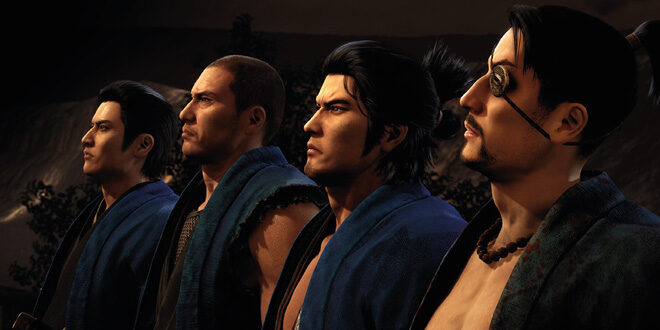 Ryu Ga Gotoku Studio’s chief producer Hiroyuki Sakamoto talks to frequent Kamurocho visitor Vince Pavey about the remake of Like a Dragon: Ishin!, while the pair avoid the swords of the notorious Shinsengumi.
Ryu Ga Gotoku Studio’s chief producer Hiroyuki Sakamoto talks to frequent Kamurocho visitor Vince Pavey about the remake of Like a Dragon: Ishin!, while the pair avoid the swords of the notorious Shinsengumi.
This interviewee’s responses have been translated from Japanese, and have occasionally been rearranged or edited for clarity.
Like a Dragon: Ishin! was first released on the PlayStation 3 and PlayStation 4 back in 2014, and we didn’t get it. Outside of Japan, the series (then known as Yakuza, before its global rebrand to Like a Dragon in 2022) was in a very different place, often trailing behind on localisation of game releases and underperforming in sales numbers and it was skipped. It was believed that the game that had well known series’ cast members play figures from Japanese history like a theatre troupe probably just wouldn’t sell, and overseas fans that weren’t importing the games from Japan were left wondering if they’d ever get to play it.
That all changed with the release of Yakuza 0, a prequel title that not only gave newcomers a jumping on point into the world of the series’ beloved characters and created lifelong fans, but propelled the series to never before seen heights in the worldwide market. Now the Like a Dragon games sell better than they ever have, and new releases arrive promptly outside of Japan and to much fanfare. Gone are the days when there’d be any doubt over whether we’d get a spin-off whatsoever, and now everybody gets to be a samurai. But how did the idea of historical video games using the Like a Dragon characters as actors even come about in the first place?
“When we decided to create a spin-off, samurai just seemed like the most interesting subject at the time.” explains RGG’s chief producer Hiroyuki Sakamoto, who has been with SEGA since the year 2000, and directed the original Ryu ga Gotoku Ishin! back on PlayStation 3 and PlayStation 4. “After Yakuza 0, we found out that if localised correctly, overseas players can also enjoy a drama about the underground society in Japan. Also, as this is made by Japanese people, we can create something that is unique to overseas players. We plan to keep that stance from here on as well.”
CHANBARA ACTION

Ishin! was not the first samurai historical game RGG Studio had created in this style, with another game called Like a Dragon: Kenzan! releasing on PlayStation 3 set in another, very different period in Japanese history. When it came time to decide on which historical figure would star in their next samurai game, Sakamoto Ryoma, a low-ranking samurai from Tosa that would go on to oppose the Tokugawa Shogunate military government, wasn’t the only one considered.
“There were a few candidates for the spin-off but we felt that the Bakumatsu setting would allow us to make something new as both a drama and a game.” says Sakamoto. For those less than familiar with the ins and outs of Japanese history, the Bakumatsu era is the time period when Japan transitioned away from being an isolated feudal society at risk of being conquered by the west, and became an industrialised nation state in its own right. Think of it like how Red Dead Redemption is set at the end of the ‘Wild West’ era of American history.
Despite ditching the word from its title overseas, Ishin! is considered to be a Like a Dragon ‘Kiwami’ title at its studio and is titled as such in Japan. Kiwami is a Japanese word that can mean either ‘ultimate’ or ‘extreme’, and the releases have so far been titles that already exist, completely remade in a brand new engine. When making a Kiwami entry in the Like a Dragon franchise, any design changes just come down to what would be the most fun, taking the chance to remove some of the friction areas from the previous version.
“For Kiwami titles, we want to make it the most current title for fans to enjoy, so we decide what to update and what to leave alone based on the features that fans will have the most fun with,” clarifies Sakamoto. “We paid particular attention to the sword and gun action, as well as the customization features and how you take your time levelling up.”
The team at Ryu Ga Gotoku were also very careful not to let contemporary games influence their decision making as they worked on the new-and-shiny version of Ishin! however, to ensure it was not a completely different experience. “We were very focused on updating the original in a way that you can play smoothly without stress, so there actually aren’t any other games we were influenced by.”
WHEREABOUTS OF LIGHT AND DARKNESS

Ryu Ga Gotoku Studio has decided to work on samurai spin-off adventures three times when learning to use a new game engine, and this time was no different, with the studio moving from their proprietary Dragon Engine to the more widely used Unreal Engine.
When asked what they would do differently now, if they had to start the project over again, Sakamoto is tight lipped. “I actually don’t want to think about that happening!” he laughs, bringing up a rather big issue they encountered early on instead.
“When we first put the art into Unreal Engine, the characters were unrecognisable due to the change in the lighting system. We solved that by adjusting the modelling,” explains Sakamoto. “I think it all comes down to the fact that things you can depict change with new technology.”
Other than Unreal Engine 4, a lot of the technologies and tools used by the team during development were the familiar old favourites that were already part of the studio’s established workflow. “Other tools we used were in-house tools that were brought over from the Dragon Engine. Those are used across the workflow process, and there are too many to list here!”
That includes their facial capturing and motion capture pipelines, which by this point are a tried-and-tested part of the cinematics of the series and their resemblance to popular Japanese dramas and films. “We still do face-capturing at the studio in our office, and our cutscenes are fully mocapped.”
While game development has obviously changed in Japan, as it has everywhere since the first time Ryu Ga Gotoku Studio made Ishin!, the biggest change for the team was instead related to the series’ recent popularity with fans in other countries. “The biggest change is how smoothly we can localise things. This is because there are now more overseas players than there are in Japan.”
THE SONG OF LIFE

When Ishin! Kiwami was announced on a livestream in 2022, it was a part of the reveal that three Like a Dragon game titles in development at once. How the team at RGG Studio balances that workload comes down to work with external contractors, and systems that have been put in place as the franchise has grown since 2005. “We of course use external contractors but the main part of it is produced internally.” says Sakamoto. “In terms of workload balance, we were able to create the structure to do this after many years of optimisation.”
An Ishin! remake being announced was an easy win for the studio with Like a Dragon’s fans, as it had been in high demand ever since the original version skipped the international release all those years ago. It turns out that the feeling was mutual. “We were just happy that we were able to announce this game since we had been receiving a lot of requests from Western fans.” enthuses the longtime series developer. The audience’s reaction was different compared to something more contemporary and new, like Like a Dragon Gaiden: The Man Who Erased His Name, or Like a Dragon 8, but excitement is excitement.
“Like a Dragon: Ishin! is a full remake title so I think it was a different reaction from a brand-new title, but we were just really glad to see that everyone was excited about this,” Sakamoto ponders. “I think there are differences, as although this is a remake, it’s pretty much a brand-new title for overseas players. I’m interested to see how people both in Japan and overseas will react to the game.”
When asked about whether he has any advice or guidance for aspiring game developers over here in the UK, the astute series producer and director makes it clear that he thinks that it’s important not to forget why we’re all here in the first place. “I think it’s important to not get caught up in stereotypes and keep an open mind as game development is forever changing.” explains Sakamoto. “I think that no matter the country, we should simply think about continuing to entertain people.”

 MCV/DEVELOP News, events, research and jobs from the games industry
MCV/DEVELOP News, events, research and jobs from the games industry




